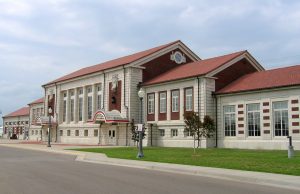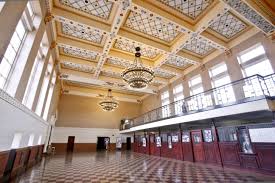Local History: Choose your depot

Great Overland Station, Topeka, 2023
Welcome back to my tour through Topeka and Shawnee County’s railroad history! After my limited results on my previous project, I switched to a subject I knew would have several paths to investigate. Railroad depots, train stations, terminals, whatever you call them, they’re the buildings where passengers arrive, depart and buy tickets. Railroad employees also used deports to communicate with each other, and where they received and distributed mail, baggage and other cargo.
There were lots of railroads operating in Kansas by the late 1800s. Every small town needed a station so there are lots of them to learn about. To complicate things, rail companies changed names a lot as companies merged or ceased to exist. Sometimes railroads shared stations (I'll talk more about that later).
Stations could be anything from grand palaces to a one room shed. As the railroad reached its peak as glamorous passenger transportation, the stations reached their peak of luxury and décor as well. Let’s look at some of the styles that existed in Topeka and Shawnee County.
Basic stations
One thing all the rail lines had in common was a basic small train station usually called “frame stations.” The Bulletin of the Shawnee County Historical Society’s article “Silver Lake UP depot: Shawnee County gem" comments that:
“Early UP , ED and Kansas Pacific depots, out of necessity, were exceedingly plain, the road needing every dime it could spare. Only later did the UP have the fiscal resources to erect handsome stations, and then primarily in the larger, more important towns. Thus, most small communities could only boast of a modest, standardized frame depot, pretty much like all the others up and down the line.”
Pauline station

Pauline station at Ward-Meade Park, Topeka, 2023
One great example of this type of station is the Atchison, Topeka and Santa Fe railroad depot that used to be in Pauline, Kansas. Pauline is seven miles south of Topeka. The depot was originally completed in 1910. It is now located at Old Prairie Town at the Ward-Meade historic site and park, and has been since 1983.
In my non-expert opinion the Pauline Depot is a great of example of a smaller station. I’ve taken commuter trains from outside of Chicago and New York City several times. But I never paid a lot of attention to the small stations before. When I stepped into Pauline Depot, I was surprised and pleased to find how much it felt a lot like those commuter stations.

Pauline station barn door
Perhaps I shouldn’t have been, because it serves the same function, and was probably built around the same time. (The combination of cars becoming more popular and the Great Depression brought a stop to most station building by 1929.) There’s a waiting room at the front, a ticket window and office in the middle, which ticket buyers could approach from inside or outside the building. There’s also a space that would have probably been a private office and cargo storage space to the back. The Pauline Depot has a sliding barn door on the end, which would have been used for loading things in and out. These stations had everything they needed to function, but not much more.
A happy medium
In many places in Shawnee County stations were upgraded as time went on. Silver Lake’s first station, built in 1875 by the Union Pacific Railroad, was a frame station like Pauline’s. According to Wallace, “the subsequent one easily would have won - outside of Topeka - as handsomest in Shawnee County.” It was built of native Kansas limestone and had large arched windows. There’s a photograph on this page. It wasn’t huge or heavily decorated, but stone buildings are made to last.
I’m not sure what the inside looked like, but you can see the same kind of shape as frame stations in the photos. It’s got symmetrical “wings” on the sides and something that might be the ticket window in the middle. It’s still very practical, but looks more permanent than a wooden frame station. Silver Lake was the only stone depot of this style in Shawnee County. Unfortunately it was demolished around 1950.
Palatial stations

Great Overland Station, Topeka, 2023
According to Douglass W. Wallace, editor of issue 89 of the Bulletin of the Shawnee County Historical Society, “The rural depot, homey and humble, might stay the same, immutable for the ages, but its city cousin evolved dramatically as each decade passed.” ( from “Handsomest in the midwest: the new UP station”) Was he right? Topeka is not the biggest city around, did Topeka’s main passenger station evolve dramatically? Did it meet expectations set by bigger, fancier stations? Let’s start at the beginning of the railroad era and see what happens.
The first railroad in town was the Santa Fe. The article “Gone and almost forgotten: Santa Fe’s Passenger Depots" by Patricia Michaelis, tells the history of Santa Fe’s stations in Topeka. (It has excellent photographs, too.) The first one was built of wood in 1869. It was remade in brick in the 1880s, and expanded and remodeled many times over the years. It continued serving Santa Fe passengers until the current station was built by Santa Fe in 1949. The brick station is also known as the first place Fred Harvey set up a restaurant that became his chain of Harvey Houses (Learn more What's a Harvey House?)
The other major railroad in Topeka was Kansas Pacific, which became part of the Union Pacific in 1880. By 1871 there was a station with a hotel attached, which was very nice for its time. By 1893, the Union Pacific hotel was losing customers to newer, fancier places.
Great Overland Station

Restored interior of Great Overland Station, Topeka, 2023
The grandest station in Topeka was (and still is) the Union Pacific station completed in 1927, now known as the Great Overland Station. Here is an article from the Topeka State Journal from Jan 27, 1927, the day before it opened, declaring it "One of the finest west of Kansas City." The photographs in the article look a great deal like what you’ll see if you visit the restored station today. As passenger train travel decreased, the station became run down and was abandoned in 1989. It was further damaged by fire in 1992. Railroad Heritage, Inc., a non-profit group, leased the building from Union Pacific to stop it from being torn down. Eventually it was restored and opened as a museum and event space in 2004.
Union stations
A “union station” served all railroad passengers, instead of just one rail line. If there wasn’t one, you had to go to a different station for each rail company. Think about what a huge pain it would be if each airline had a separate airport. Also imagine you had to take a horse-drawn carriage to get there! It was really like this for train passengers in Topeka. The Kansas Pacific and then the Union Pacific had their station north of the Kansas River, and Santa Fe’s was south of the river. Neither company wanted to change location, mostly because their trains would lose time traveling from the main track to “park” at the station.
I read quite a few articles from issue 89 of the Bulletins, which is entirely about the Great Overland Station and earlier local stations. Every article about new and improved train stations in Topeka, from 1871 onward, mentioned the possibility of a union station. There was even one plan to build a station that spanned the river! (There’s a sketch in this article so you can see what it might have looked like.) But despite the talk, there was never a true union station in Topeka. The Rock Island railroad eventually had its trains use the Union Pacific station, so technically it was a union station. But Santa Fe continued using its old brick station until they built a smaller, more modern one in 1949. This became the current Amtrak station in 1971.
My final judgment is that the Great Overland Station is indeed a palatial station suitable to a city the size of Topeka. Shawnee County is lucky to have preserved examples of both little and large railroad stations. I highly recommend visiting!
Credits & more info
Thanks to Robert Chitwood of the Topeka chapter of the National Railway Historical Society for giving me a private tour of Pauline Depot and discussing sources and topics to consider for this railroad “journey” I’m on. Thanks to Gena Brooks with Shawnee County Parks and Recreation for letting us access the depot on a weekday afternoon in the middle of winter.
Read more
- "The Pauline Depot"
- "Last Call for Rossville" Rossville’s was also one of the plain stations much loved by its community. In 1969, protests from the Rossville community helped save this Union Pacific station, but it burned down in 1978.
- What's a Harvey House?












